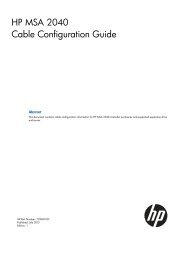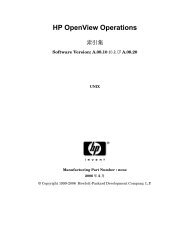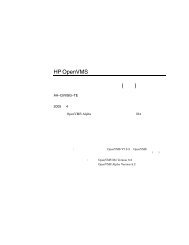HP ProCurve Wireless Access Point 420 - Hewlett Packard
HP ProCurve Wireless Access Point 420 - Hewlett Packard
HP ProCurve Wireless Access Point 420 - Hewlett Packard
Create successful ePaper yourself
Turn your PDF publications into a flip-book with our unique Google optimized e-Paper software.
<strong>Access</strong> <strong>Point</strong> Configuration<br />
Configuring <strong>Wireless</strong> Security<br />
5-54<br />
• Local MAC: The MAC address of the associating station is compared<br />
against the local database stored on the access point. The Local MAC<br />
Authentication section enables the local database to be set up. The<br />
access point supports up to 1024 MAC addresses.<br />
• Radius MAC: The MAC address of the associating station is sent to<br />
a configured RADIUS server for authentication.<br />
• Disable: No checks are performed on an associating station’s MAC<br />
address.<br />
■ Local MAC Authentication: Configures the local MAC authentication<br />
database. The MAC database provides a mechanism to take certain<br />
actions based on a wireless client’s MAC address. The MAC list can be<br />
configured to allow or deny network access to specific clients.<br />
• System Default: Specifies a default action for all unknown MAC<br />
addresses (that is, those not listed in the local MAC database).<br />
– Deny: Blocks access for all MAC addresses except those listed<br />
in the local database as “allowed.”<br />
– Allow: Permits access for all MAC addresses except those listed<br />
in the local database as “denied.”<br />
■ MAC Authentication Settings: Enters specified MAC addresses and<br />
permissions into the local MAC database.<br />
• MAC Address: Physical address of a client. Enter six pairs of hexadecimal<br />
digits separated by hyphens, for example, 00-90-D1-12-AB-89.<br />
• Permission: Select Allow to permit access or Deny to block access.<br />
If Delete is selected, the specified MAC address entry is removed from<br />
the database.<br />
• Update: Enters the specified MAC address and permission setting<br />
into the local database.<br />
■ MAC Authentication Table: Displays current entries in the local MAC<br />
database.<br />
To Configure MAC Authentication Using a Local Database:<br />
1. Select the Security tab.<br />
2. Click the [Authentication] button.<br />
3. Set MAC Authentication to Local MAC.<br />
4. Under Local MAC authentication, set System Default to Deny. This blocks all<br />
unknown MAC addresses from gaining access to the network.<br />
5. Click the [Apply Changes] button.<br />
6. Under MAC Authentication Settings, enter an authorized client MAC<br />
address in the MAC address text field.

















